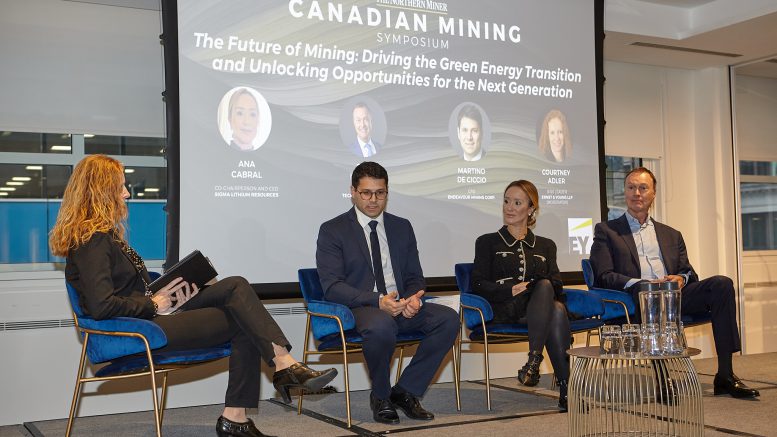The future of the industry depends less on creating everything anew and more on using what is already known in new ways, mining leaders said on Thursday in London.
Innovation and an openness to diverse thought are key drivers of change in the decades to come, panellists in “The Future Of Mining – Unlocking Opportunities for the Next Generation” told The Northern Miner’s Canadian Mining Symposium.
“Mining is the transition [to green energy]”, Ana Cabral, co-founder and CEO of Sigma Lithium Resources (TSXV: SGML; NASDAQ: SGML), said in response to moderator Courtney Adler’s question about what role the industry will play. Adler is risk leader at global accounting firm EY, which sponsored and organized the panel.
“Without mining there is no transition,” Cabral said. “Unfortunately, mining hasn’t behaved in line with the energy transition into green. Mining has been quite brown over the last few decades.”
The mining industry may be at a pivotal juncture balancing new demands for green metals with increased calls for environmental accountability. How mining can take advantage of its enhanced role to replace fossil fuels, improve its image, adopt new technologies, protect the environment and increase diversity were some of the topics covered during the discussion.
The industry will have to adopt more qualities of the tech sector, such as becoming more environmental and cost-conscious especially as critical mineral miners further integrate themselves with the electric battery supply chain, Cabral said.
“It’s a volume business. It’s not about owning your little niche and driving prices up. It’s more about iron ore than rare earths. The car makers are now tech companies,” she said. “We need to be more tech than base industry.”
Image change
But as mining takes a more prominent role in the multi-faced transition to zero emission technologies, the industry faces public skepticism. How, asked Adler, can mining improve its negative perception?
Transparency and educating the end user are how Endeavour Mining (TSX: EDV; LSE: EDV) is doing its part, the company’s Deputy CFO, Martino De Ciccio, said. Endeavour’s gold products are traceable with QR codes back to where the metal was mined at their projects in West Africa.
“Jewellers and designers come to our Ity mine to see the difference we’re making. Ninety-five per cent of our workforce is local. This needs to be sustainable,” De Ciccio said. He also explained that Endeavour’s mines buy only 20% of the food grown locally so local food supply chains don’t become dependent on mines and risk collapsing when they close.
Turning to the role of technology in the future, Adler asked the panel what sustainable innovations have been deployed in protecting the environment.
Cabral, who was named The Northern Miner’s Mining Person of the Year for 2022, said Sigma has done a lot in that area, but without inventing anything new.
She explained that Sigma’s approach to innovation is comparable to walking into a room full of lego blocks and building something with them in ways that nobody had considered. She likened that to the company’s achievements producing spodumene concentrate with no carbon emissions, 100% recycling of water and no tailings ponds.
“As an industry we need to be doing that all the time. We need to walk the talk. In 2019, I was hammered by decisions…that were obvious for us in terms of environmentally friendly policies. Like dry stack tailings. It cost almost nothing to do those innovations.”
Innovation approaches
Don Lindsay, former CEO of Teck Resources (TSX: TECK.A/TECK.B; NYSE: TECK) agreed. “Innovation isn’t necessarily about technology, it’s someone having an idea on how to do something better,” he said.
Lindsay offered the example of a $25-million fund he set up during his tenure at Teck to hire 250 experts from tech companies who didn’t necessarily have mining backgrounds. He asked them to send him ideas to reduce environmental footprints or improve efficiency. Their input faced resistance from mill operators at the Highland Valley Copper mine in British Columbia, but eventually some of their ideas were put into action.
“We targeted 2-3% increase in recovery and throughput and the next day it was 3-4% and that alone was worth $50 million. That builds the excitement and they wanted to go to sites and other companies and [make improvements,]” Lindsay said.
The panel turned to its final issue, the importance of diversity, and De Ciccio said he believes different ways of thinking come from the regions where miners operate.
He explained that 94% of Endeavour’s workforce is local, and the company tries to promote as many locals as possible to higher levels. That means that 70% of its department heads are local people in West Africa. There may be industry labour shortages in the United States, Australia and Canada, but not in Africa, he said.
“Five to 10 years from now I would expect people who were training at our mines to be running mines in the U.S., Canada and elsewhere. That will drive change as well,” he said. “You have people with different values and training, even if they haven’t gone to Ivy League schools.”






Be the first to comment on "CMS: Bring new openness to innovation, diversity, future-of-mining panel says"